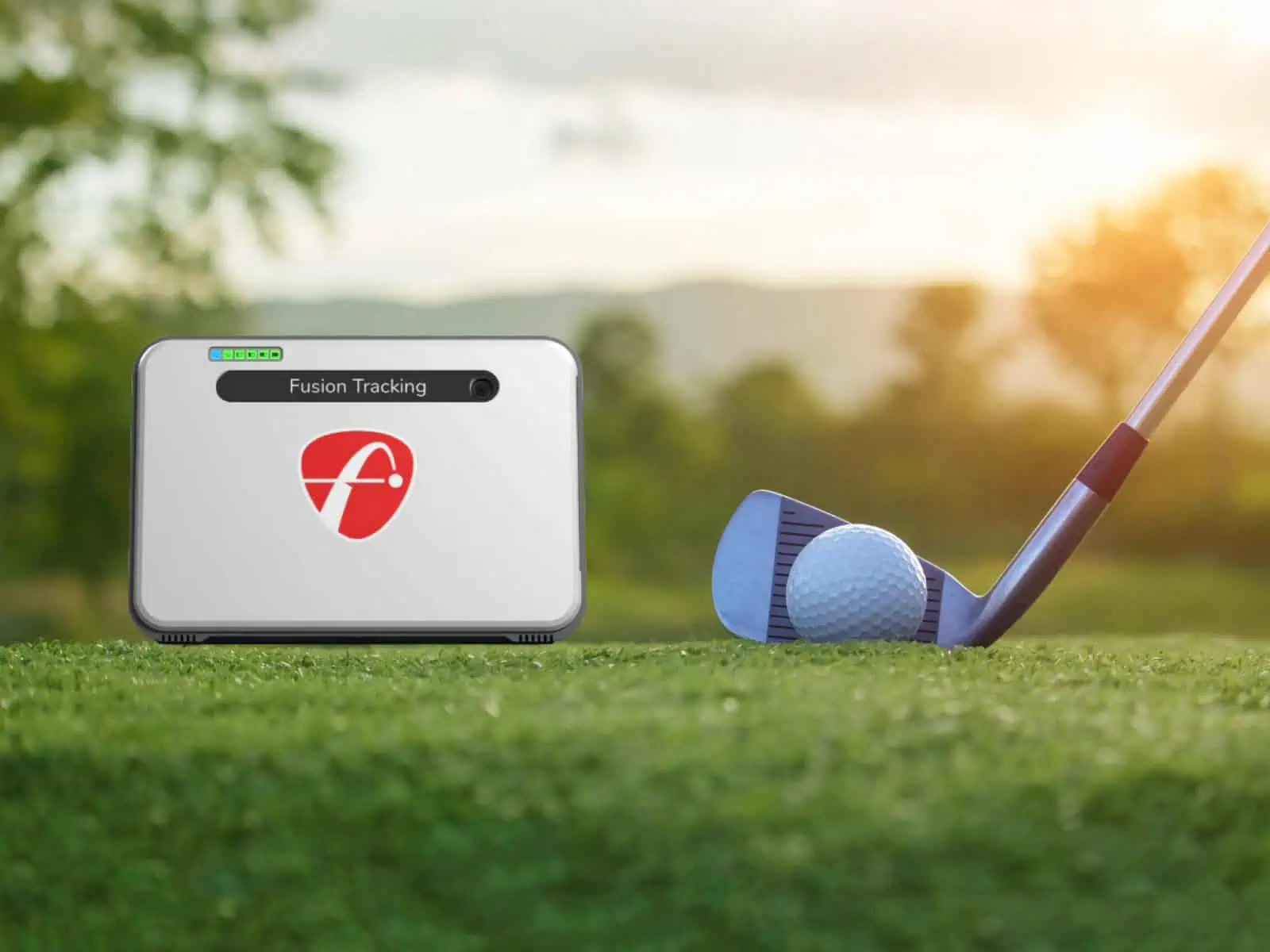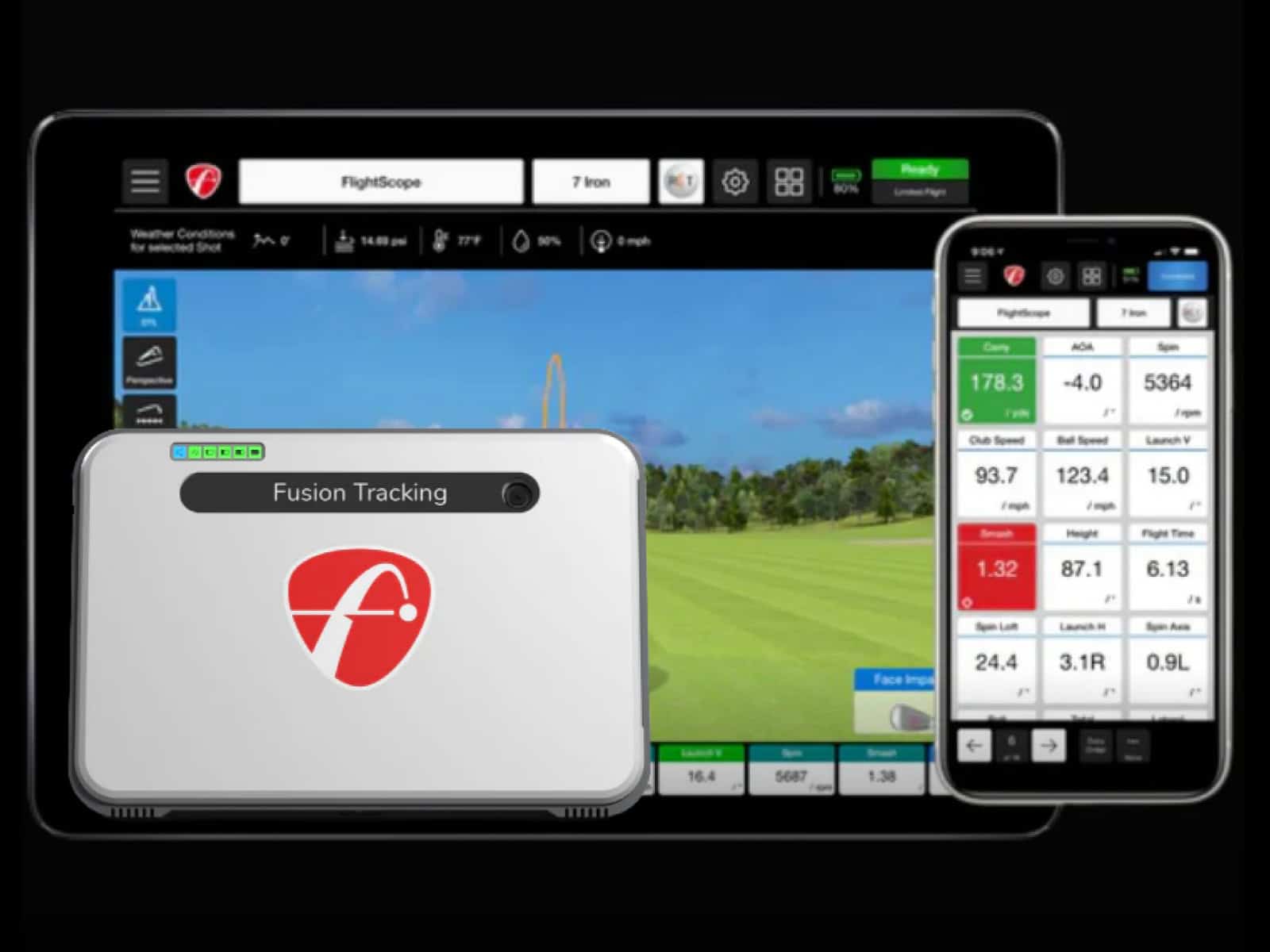So, your dream of an indoor golf simulator is nearly coming true, but you are stuck on the idea of the room size where you’ll get the complete simulator experience without compromising your swing and style.
The room size for the golf simulator is the foremost thing to look for. It includes taking care of the ceiling height, length, and width of the space where your simulator will be installed.
This definitive guide will be a must-follow. All the specifications in the article are researched and analyzed by our team members, who are all golf enthusiasts.
Check Also: Is 10 Feet Width Enough for Your Golf Simulator?
The Importance of Allocating the Proper Space for A Golf Simulator
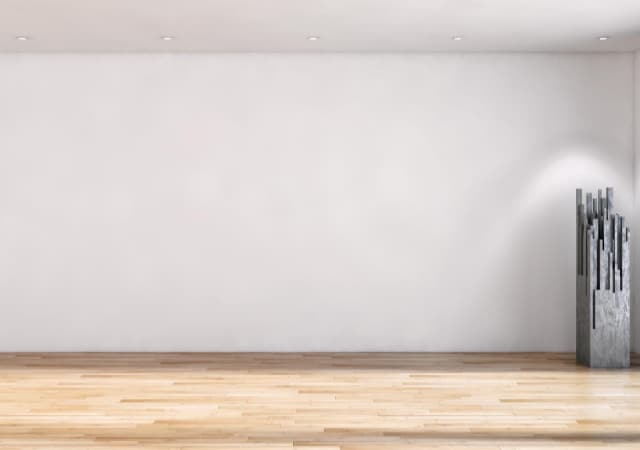
As hinted earlier, your swing must never be compromised in any case, and that’s why getting a room with proper dimensions is advised before getting a golf simulator.
With every indoor simulator purchase, a handbook is included that contains the required room size. Following the criteria can help you have a better simulation experience.
If your space is tiny or has a low ceiling, you may not be able to obtain the whole and most incredible collection of components that you had hoped to include in your indoor simulator. But still, the options are vast. We won’t let you drop the idea of getting a simulator.
What Size Room Do You Need for A Golf Simulator?
For a golf simulator, the room should have dimensions of 12x10x8 (LengthxWidthxHeight) at least. However, it is advised to increase the length to 16 feet, with a width and height of 12 ‘and 9’, respectively, for a more comfortable swing.
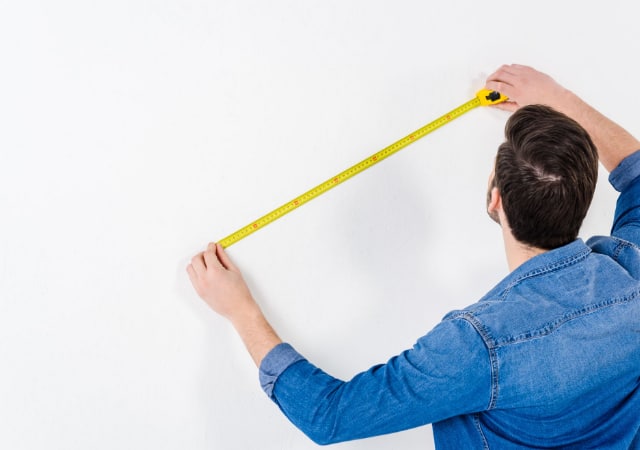
The point of keeping the room dimensions as advised is to make the simulation experience beneficial. So, the larger and broader room you can arrange for a simulator, the better for improving your game.
If you have limited space and are considering 10ft wide options, we have a dedicated guide on golf simulator packages for 10 feet width that explores suitable packages and space-saving solutions.
How Much Room Do You Need to Swing a Golf Club Properly?
The required distance from the screen to the hitting mat (tee point) is the main reason for keeping the room long enough. However, better accommodation of different simulator components is another reason for measuring the room length beforehand.
Usually, it is required to keep approximately 6 feet of space above and behind you and almost 10 to 12 feet all around you.
Above are the dimensions needed for you to swing your club properly. Still, if one or more of your acquaintances is taller than average, then you must also keep that in mind. You’ll need more height, width, and depth for the room.
Another critical issue you can try to avoid is players on your opposite-hand side; lefties if you are right-handed, and righties if you are left-handed. As suggested by the manufacturers of golf simulators, lefties need more room for a comfortable swing because they have a wider golf swing.
We suggest watching this step-by-step guide ( 1 minute and 33 seconds) to guide you through the process of measuring the room dimensions for an indoor golf simulator:
How Much Room Length Do You Need?
An area of at least 12 feet of depth is suggested for an easy swing. Of course, another foot or two might add to the goodness of your game if nothing else.
If increasing the room depth or choosing a larger room is not difficult for you, then we advise you to increase the length by 4 to 6 more feet for comfortable placement of the components of the golf simulator as well as your proper swing (backswing).
This distance allows the installation of additional components (more cameras, mirrors, etc.) and the use of different tracking systems (as we know that radar-based launch monitors require more room length for optimal detection).
Importance of The Distance Between The Wall and The Impact Screen
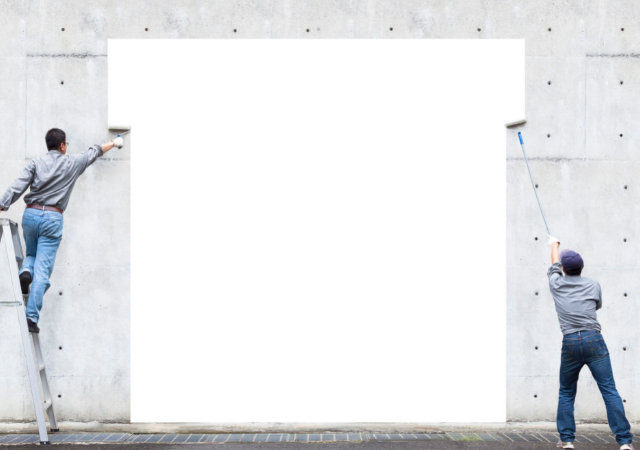
The distance between the wall and the screen must be added to the overall length of the room.
If you don’t take care of the space between the room’s walls at the back side of the impact screen, the ball might ruin the room’s contents while traveling at high speed after impact. In addition, it can physically harm both participants and components.
So, keep at least a foot or more between the room wall on the back side of your impact screen.
What if You Don’t Have the Proper Room Length?

You will be sacrificing the reason you opted for a golf simulator, i.e., the game’s improvement.
A shorter room will affect the ball’s trajectory, and your room and its contents will be at risk of getting damaged.
The efficiency of a launch monitor will be compromised if a room chosen is too short in length. There won’t be proper placement of cameras, which ultimately causes Doppler radar launch monitors to malfunction (by reporting erroneous data).
However, don’t worry; if you cannot do anything with your smaller room. We still have some options for you to play indoors (discussed below).
How Much Room Width Do You Need?
Another important factor in choosing a room for a better simulation experience is the width of the room. Room width is critical if you have longer clubs or want to have a driver shot.
Depending on the availability of the space, having 10 feet width is the minimum but should be enough, 15 feet will help you have a comfortable swing and even a centered aim (with the tee point facing exactly the center of the hitting screen and equal distance being left to the right and left).
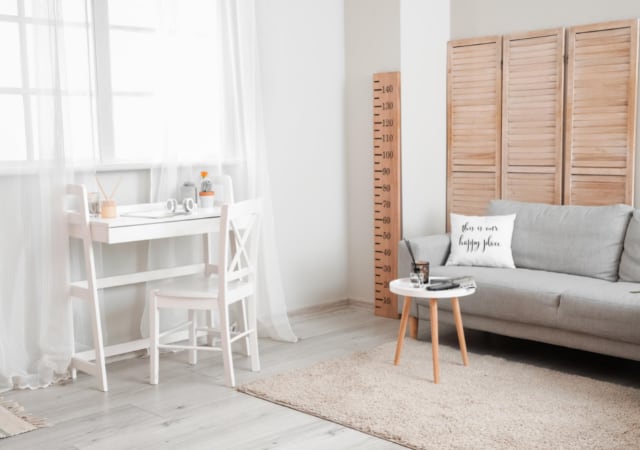
What if You Don’t Have a Proper Room Width?
Insufficient room width is unfortunate for longer clubs. One might find it difficult to play with them. Other than that, left-handed players (and taller ones) will have their swing compromised.
Your side walls will risk getting damaged if you have an improper room width. Also, because you will move to either side of the room, you might develop habits of fades and slices, which is not the goal of playing golf on the simulator.
How Much Ceiling Height Do You Need?
To get the most out of the simulator, you should make sure the ceiling height is at least 9 ft. If you are exceptionally tall, you may need to add a foot or more. You should never try to play virtual golf in a room with a low ceiling height.
Doing so could easily cause a catastrophe for your ceiling and the simulator components, especially if you have a projector, light bar and/or launch monitor that can be ceiling-mounted.
You should also be aware of the projector placement. Once again, it is recommended that you choose a height that will keep it safe from any potential damage. Check out this detailed golf simulator ceiling height guide for more info.
Swing your longest club and make sure it doesn’t reach the projector or even come close to it; constantly thinking about your driver coming too close to the ceiling components will cause you to lose focus and eventually ruin your game!
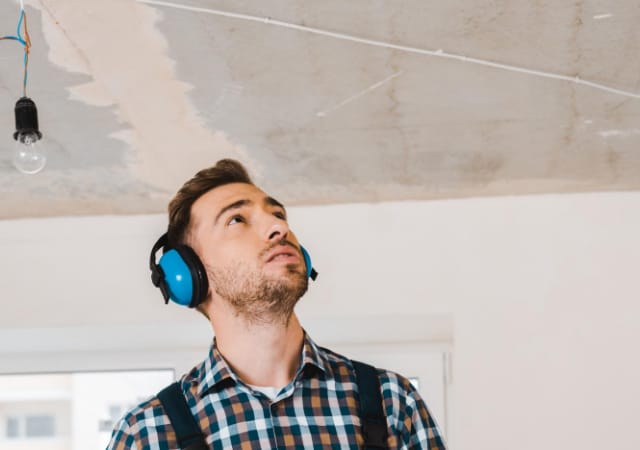
What if You Don’t Have a Proper Ceiling Height?
If you don’t have a proper ceiling height and have a flat swing, you may be comfortable swinging beneath it. In other situations, if a flat swing is not your thing, you will have to change your swing style to work in a low ceiling height situation. Of course, you could try to swing more flatly to avoid hitting the ceiling while swinging, but that’s not what a golf simulator is about (you may ruin your swing by doing so).
With a low ceiling height, the ceiling mount projector will be at stake. A shot with a full swing might meet up the first and last time with the projector because it will be significantly affected.
So, a low ceiling will limit your component choices; for instance, you may be obliged to use a floor mount for your projector and totally forget about overhead launch monitors like the Uneekor EYE XO, QED, FS GCHawk, Trugolf Apogee, etc.
Furthermore, If you want to buy a whole golf simulator enclosure, be sure to check that it will fit in your available area. You might not be able to fit a larger enclosure like the SIG12 or SIG10.
Do You Have Enough Space to Hit the Center of the Screen?
You must ensure your simulator is set up with a wide enough area depending on your height, swing style, and enclosure.
A good rule of thumb is that your room must be 15 feet wide. This width allows for seamless hand switching and a centered aim, which allows the setup to accommodate righties and lefties without issues.
Your golf simulator should (preferably) have a centered aim, which requires aligning the hitting mat and tee point with the middle of your screen. The result is that the setup will accommodate right-handed and left-handed players without moving the tee point or mat.
Is It Possible to Offset the Target Line on a Golf Simulator?
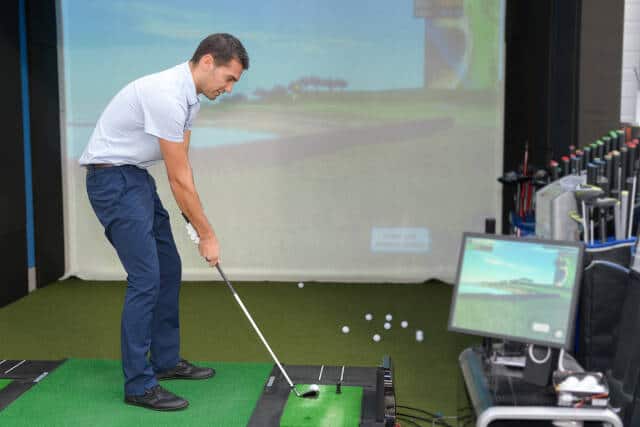
You can offset the centerline of the simulation using some great launch monitor software on the market, like Skytrak’s. It will help you treat your slice problems by providing more space.
You can also move the launch monitor and hitting mat from the center towards the sides to help you swing more comfortably. This is especially useful for those who don’t have enough room width to have a centered aim; so, they either move the mat and launch monitor to the right (for a righty) or the left (for a lefty) to swing more comfortably without hitting the wall behind them while back swinging.
However, other software options like World Golf Tour or The Golf Club 2019 do not help offset the target line; thus, hitting off-center with this software becomes a more challenging proposition (we think future versions will probably include this option).
If you don’t have enough space for a centered aim, we highly recommend checking if your new simulator’s software allows for target line offsetting before you finalize your purchase.
Other Room Dimensions to Measure
Length, width, and ceiling height are the most critical factors when establishing a golf simulator in a particular room. However, there are some more dimensions to consider in this regard. Let’s have a look!
Distance from Hitting Mat to Impact Screen
Keeping the appropriate tee-to-screen distance is the next most crucial thing after calculating the primary dimensions of your room. Again, keeping at least a distance of 12 ft from the screen to the hitting mat is suggested.
Not following the suggested distance might help you to hit a shot, but your launch monitor will struggle to detect your ball’s flight and launch properties.
With that said, the distance between your tee point and impact screen should be between 8′ and 12′. Going under or over that range may (and probably will) affect the accuracy of the simulation.
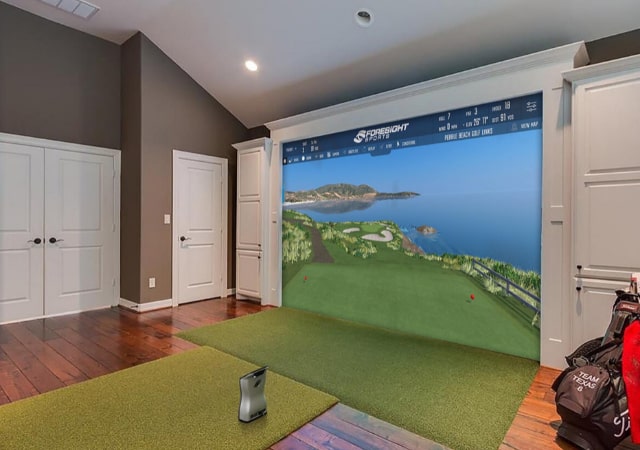
Distance from Launch Monitor to Hitting Mat
If you are a golfer with less space than required, then you should be grateful to the manufacturers of the photometric launch monitors that they need only a distance of 22 inches (to the side of the tee point, perpendicular to the target line) to track and record your data.
However, a radar doppler will need a distance of almost 6′ to 8′ behind the tee point to work properly. That translates into a total distance of 14′ to 18′ between the screen and the launch monitor; that’s because radar systems need some flight time for the ball to track its metrics, as opposed to photometric systems, which do the tracking at the moment of impact.
Failing to have enough space between the hitting mat and the launch monitor will greatly affect the quality and accuracy of the indoor golf experience.
Do You Have Room for Anything Else in Your Simulator Room?
You already have a workable simulator by now (if you followed our guidelines), but to spice up your experience, there are some gadgets you can add to your simulator room.
You can install cameras that record your swing style and some perfectly placed mirrors to make your simulation experience a better one and provide visual feedback on your stance and swing.
Before you start adding all the bells and whistles to your simulator room, be sure it’s properly protected from errant shots. Even the most skilled golfer can miss the sweet spot occasionally, and that’s where the golf sim wall padding comes in. It shields your walls and equipment from damage, saving you frustration and costly repairs.
What About Space for Seats and Other Items?

If you want your simulation experience to become a friend or family gathering, you must consider placing seats and maybe a drink bar in your room (or even have a simulation studio).
You can also use this room as a home theater when not using the simulator. Just a reorganization of the seats is needed, and voila! You can watch your favorite movies there.
A larger room will allow you to install additional HD TVs on the side walls, add some equipment racks and organizers, or create a separate practice area that players can use while waiting for their turn. The possibilities are endless with a larger space.
Cheaper Options for Restricted Space
The paragraph above suggested ideas for room simulators for people without the hurdles of limited space. But, if you have restricted space, you can still use a simulator. We don’t want you to drop the idea of playing on a golf simulator setup only because you have limited space.
We suggest you use a hitting bay to play with a launch monitor. It doesn’t occupy too much space, and you can play with any club you want.
Alternatively, you can opt for a system with a retractable screen for more convenience.
Using a partial setup (with a golf net) is one way to go; you may also restrict your practice sessions to shorter clubs only. These are not the best solutions, but they’re still better than nothing!
Different Types of Golf Simulator Room Sizes
Based on our research, we can safely divide the simulators into two major types depending on their sizes.
Mid-Size
An average-sized setup will require around 16’L x 12’W x 9′ H. You can set up a mid-size simulator in your room if you have a ceiling height of at least 9 ft. To ensure a better virtual experience, the distance between the impact screen and the hitting mat must be around 10′.
You should leave around 4′ of space behind you to have a comfortable backswing if you are using a camera-based system. A radar unit will require more room depth.
How Much Does a Mid-Size Package Cost?

You can get brands like Foresight Sports, Trugolf, and Uneekor in the price range of $9000 to $20,000. This is because they are mid-sized simulators. Below are our suggested packages for medium size cost:
Uneekor QED SIG10 Golf Simulator. Get it on this page; ($13,199).
Foresight Sports GC3 SIG12 Golf Simulator Package. Get it from here; ($13,899)
TruGolf Vista 8 Golf Simulator. Get it from here; ($9,895)
Large Size
You need to be a die-hard fan of golf and simulators to offer a large room for the cause. A large-sized simulator room would be around 20′ long with half of that as the ceiling height and approximately the same 10′ to be distance between you and the impact screen.
The length would easily cover every add-on, like mirrors, speakers, and even seats.
How Much Does a Large Size Cost?
You should be ready to spend $40,000 or more for a premium golf simulator. Brands like Full Swing, HD Golf, Trackman, and others provide you with the option of large-sized, high-end simulators. You can choose any of them that suits the space you have. The following are the starting prices of the high-end simulators:
Trackman, You can get it here;( $45,490)
Full swing Golf, Get it on this page; ($44,900)
HD Golf: Get the Ultimate Entertainment Package here ($69,035), and the Ultimate Training Package here. ($56,420)
Are Your Garage and Basement Spaces Ideal for Golf Simulators?
Absolutely yes. The garage and basement are excellent spaces for installing a home golf simulator. With enough ceiling height, you can swing your driver and longest clubs comfortably. Besides ceiling height, you should have ample distance in terms of length and width.
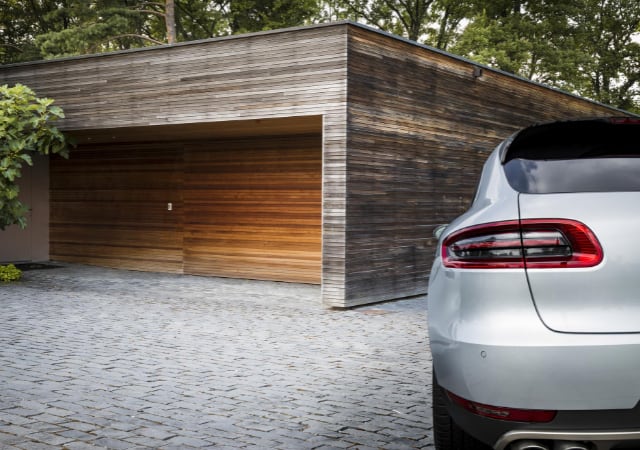
A small flaw that can easily be fixed is temperature control. You will need to install heaters to keep your garage warm, especially on a cold day.
As for the basement, you also need to pay attention to a few things. It is a thermos-like space, never bothered about the temperature outside the flask; temperature control shouldn’t be difficult to achieve.
However, one thing that may bother you is a bit of short height (as is the case with many basements). If that’s the case, you should either drop the idea of playing with your driver or renovate your basement by digging it deeper (which will add to your total investment).
Space Requirement for Golf Simulators Based on Their Types
Understanding the technology used by the launch monitor in your simulator for detection might assist you in determining which type will function best in your designated location.
Some high-end simulator packages use multiple types of tracking technologies to do the detection. Let’s have a closer look at them.
Photometric
Photometric simulators use high-speed cameras to analyze your swing in minute detail. They take shots at different angles of the golf ball and analyze information like spin, ball flight, ball speed club path and speed, etc.
This technology offers statistical data and footage of your swing to help you improve your technique. It also provides instant feedback on the game, whether there’s room for any improvement or not.
Video recording playback with data overlay is another great feature of photometric units. That’s why big brands like Foresight Sports, HD Golf, SkyTrak, etc. use it. Even high-end radar units like Trackman and Flightscope’s X3 include cameras to enhance their tracking capabilities.
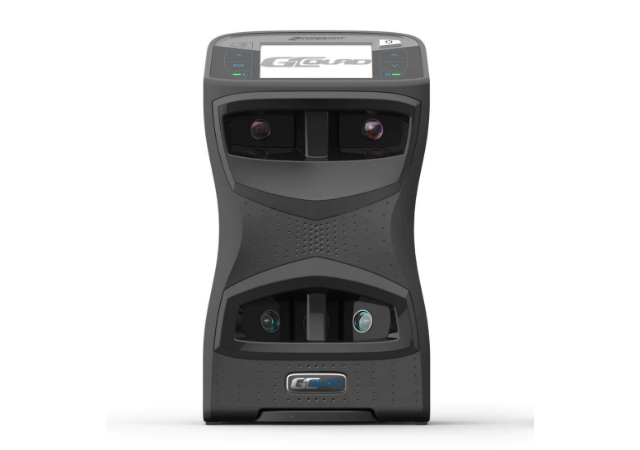
Doppler Radar
You should drop the idea of getting a Radar Doppler Launch Monitor for your simulator if you don’t have enough room, and by enough, I mean at least 16 feet of distance from the net to the launch monitor position. This is the recommended length for this kind of launch monitor.
If you try installing it in a shorter room than recommended, you’ll have miscalculations and inaccurate results. Radar Doppler systems are exclusively made for outdoor arrangements or rooms that are deep enough (16 feet or more).
Doppler Radar technology uses microwave beams to hit the moving ball and club and record the relevant data.
Trackman, a highly-rated golf company, uses this technology in its launch monitors. The same goes for the equally impressive Flightscope X3 or Full Swing’s entire lineup of systems (manufactured in collaboration with Tiger Woods).
Many pro golfers swear by the accuracy of the radar-based Trackman units.
Infrared
Infrared is another popular kind of detection technology used to capture the position of the clubhead during the swing. It is also the cheapest among all three types.
It uses a light source that bounces off the club face and measures the angle the clubface is facing when it strikes the ball.
The most popular Infrared-based sim packages are made by Optishot, with their leading and affordable Golf-In-A-Box series of sims with a starting price of only 1000 dollars.
Conclusion
Your golf simulator must have the proper proportions. With the appropriate size, you may anticipate a realistic virtual experience. However, if you want to build or buy a new house and dedicate some more room to your favorite sport, you’ll need to do some calculations. First, your dedicated area must meet the manufacturer’s absolute minimum dimensions for the package you wish to purchase.
Everything you need to know about golf simulator space requirements is covered in this article. In addition,we explored how to calculate the proper height, length, width, and other distances of the golf simulator.
Properly preparing your simulator space goes beyond just allocating the right dimensions. Ensuring you have adequate padding for your walls and ceiling is also important for safety, performance and experience. Check our padding guide for recommendations on materials, installation and key considerations.
If something is still bothering you about golf simulators, or if you need any advice regarding your setup, we are here to help you wholeheartedly!




